Let me start with a disclaimer: I’m not into the Conan canon. (CONAN CANON CONAN CANON)
I never even watched a Conan movie, and I only vaguely remember reading one short story (it had an elephant, I’m quite sure). I enjoy the Sword and Sorcery genre, and I’ve got nothing against the Conan mythos, it just so happens that this particular piece of Western culture simply passed me by, so I never got excited by it.
I am now.
What is it About
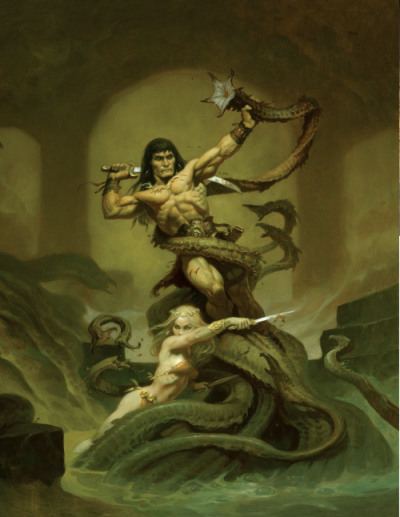
Conan: Adventures in an Age Undreamed Of is a game about great deeds and black magic, about surviving in a harsh and cruel world. It’s not about good heroes defeating evil villains; your morals are quite likely going to be on the “questionable” side of the scale, but that’s just the world you’re living in. High ideals are hard to come by, and decency is a scarce resource.
It’s a game about going through dangerous adventures, meeting dangerous people, and facing them in dangerous action scenes. These scenes are quite dynamic and dramatic, and are just as likely to have intimidating displays of prowess as they are to include a fierce strike that breaks the enemy’s shield. Combat is cool, brutal, and interesting.
Many challenges await those who dare, and glory only comes to those who try. You’ll discover the forgotten treasures of ancient cities ruled by ape-men, and return to civilisation as a glorious conqueror… But you’ll lose most of your fortune, and perhaps some of your glory as well, while carousing (there’s a table for that) or when paying potential powerful patrons. You won’t be counting the exact number of rations or keep track of arrows, there’s a simple Upkeep cost that quickly takes care of all the uninteresting bits of adventuring life.
Over time you’ll be building your legend, renown and abilities, but unlike the relatively straight and “calm” way D&D handles your progression, the adventurer’s life in Conan is a rollercoaster ride of gaining and losing wealth and influence. This is a common trope of Sword and Sorcery, and your next adventure might start with the GM saying “You’re all slaves on Black Silk’s pirate ship, on the way to be sold on the markets of Stygia”. It’s up to you to escape, and perhaps take control of the ship!
All of this is very well implemented, both with clever rules and with an excellent Gamemaster section.
How it Works
The basic mechanic of Modiphius 2d20 goes like this. You roll a few d20s (two as default, but you can gain up to three more with various aids), checking each to see if they got a number that’s equal to or lower than the Attribute that’s most relevant to what you’re doing; you want as many such successes as you can get. If you’re skilled, you add the skill’s Expertise to your Attribute, and skills also have a Focus, a number under which you’ll get 2 success.
For example, let’s say you’re trying to jump between two roofs (there was a misunderstanding with a jewel and an angry cultist, nevermind now). You’re rolling 2d20 and try to score under 12: Your Brawn is an average 9, but you’re really athletic, with a 3. Your Athletic Focus is the basic 1 (you haven’t invested in it yet; not a wise decision apparently), so if any d20 gets a natural 1, you’ll get two successes. Let’s say you head a great head start on your run, so the GM says you get to roll another 1d20. You roll all three and count the successes.
Oh, and if you get a natural 20? That’s a Complication; think Threat or Despair from Edge of the Empire.
Every action has a Difficulty, which is the number of successes you need in order to do whatever it is you’re trying to do. If you don’t get enough successes, you fail; but what if you get more successes than the required amount? The extra ones become Momentum, which you can spend in order to enhance your success in various ways. In combat you can use Momentum to penetrate through armour, disarm your opponent, hit another target, gain some confidence, disengage, etc; while out of combat you might use Momentum to ask the GM a question about the situation, re-roll the dice, notice something important, finish the task faster, add powers to your alchemical concoction, etc. Unused Momentum is added to a group pool, for everyone’s use, but this pool slowly fades as you all, well, lose momentum.
This is the main thing of Conan, and it works.
I find that Momentum as a mechanic allows for creative storytelling. It’s an enabling mechanic, not a restrictive one. It’s a quick way of turning your cool ideas into something the rules “understand”. Let’s say you want to do something cool, like breaking the edge of the wooden roof right after you land, so it’ll be harder for your pursuers to jump after you. Does it sound like a variation on a success? Yeah. So it should probably be implemented as a Momentum cost of 1 or 2.
The GM, you should know, doesn’t generate Momentum. Oh no, she has something much better: DOOM!
Cool Highlights
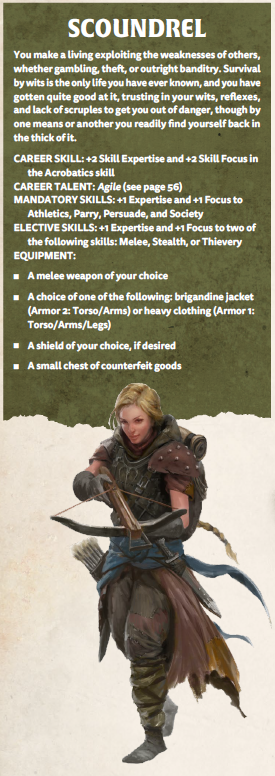
Doom. Doom is the currency of making things difficult for the players. Not in an adversarial way, but in an engaging, dynamic way. Doom can be used to make things harder, by increasing difficulty or helping enemies, who can spend it as if it was Momentum. It can also be used in “Doom Spends” that various monsters and environment have, and allow them to make the scene more engaging and challenging.
Doom is the general, all-purpose token of the GM, and she can gain it in various ways. The sound of Pict war horns echo around the forest? Time for a Discipline skill check (to avoid the loss of Resolve, see later), but it’s also foreshadowing the arrival of the Picts – the GM takes a few Doom tokens to make this feel real and threatening. This is literally an omen of doom. The players discuss among themselves what to do, and it takes them ages? The GM takes Doom. Someone rolled a Complication but no one has an idea for one? Default to “take 2 Doom”.
Initiative. I love this! The initiative system is so simple: PCs go first, in whatever order they want, and then all NPCs, in whatever order the GM want. If the GM wants to have someone act quicker, she spends 1 Doom, which allows this one NPC to act before the PCs. This works very well.
Skill Talents. Each skill has a Talent tree, reminiscent of the Charm trees in Exalted. Generally speaking, they are all great. Again, there’s a lot of enabling here: if you imagine a character who’s not really talkative, but can read a person so well that they can influence them with just a few words, invest in the Insight skill and take the See the Soul Talent, that allows you to use Insight instead of Society and Thievery (!) on human mortals. Instead of wasting XP on skills that aren’t really suited for your character, Talents such as this allow you to do with you existing skills the things that everyone knows you should be able to do, as a specific aspect of that other skill.
Other great Talents include Linguistics’ Body Language (You can speak with any living person so long as there is no immediate distraction that would prevent communication), or Parry’s Stage Fighting (you can attack with your Parry skill, dealing only nonlethal damage, and all tests to spot your fakery are 1 step more difficult).
Just imagine the cool scenes you might find yourself in, with these Talents. The Sorceress Queen ordering the party members to attack each other for her entertainment, and you do a mock-fight, convincing her you killed your friend, allowing him to escape as the “body” is thrown out!
Despair. The basic “damage” mechanic is quite simple. Vigor and Resolve measure your short-term physical and mental stamina. They regenerate completely after even a few moments of respite. If you lose them all, or suffer 5 or more points at one time, you gain actual Wounds and Traumas, which suck, and might kill you. So how do we simulate the effects of the attrition of adventuring life? With Fatigue and Despair, which simply reduce your maximum Vigor and Reslove. You climbed a tall cliff and got a Complication on the roll? Well, you’re somewhat fatigued, take 2 points off your maximum Vigor until you rest. And I mean rest-rest, not “in a muddy ditch”-rest.
This is not only fast and simple, it also feels like getting fatigued and despaired. You’re tired, it’s a lot easier to deal you actual harm – you have fewer points of vigor separating you from getting a wound.
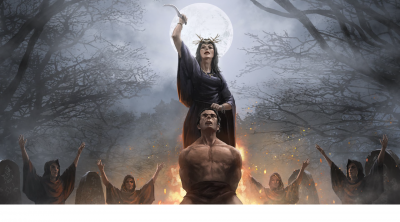
Displays. I love this. I love this. As already noted, mental damage is totally a thing in Conan, and so, everyone can try to Threaten as a basic form of attack. But you know what’s really threatening? Displays of Might and Power! There are several displays, each with its own requirement and the skill you’ll need in order to activate it. Here are two:
“Dead Man’s Stare: The character brandishes the severed head of an enemy at arm’s length, raising the grim trophy high for all to see. This violent action, drenched in gore, deters all but the most hardened foes. For extra emphasis, the head can be dropped dramatically, cast away as if refuse, or tossed into the hands of a hapless target. Requirement: The head of a Toughened or Nemesis
enemy killed during that scene. It takes a Minor Action to sever the head to brandish it in this fashion.
A Mighty Name: The character’s reputation alone is enough to make enemies hesitate. The character must have a Renown of at least 3. Unlike normal requirements, this is persistent: the character is either notorious enough for this to work, or isn’t.”
This is so Conan!
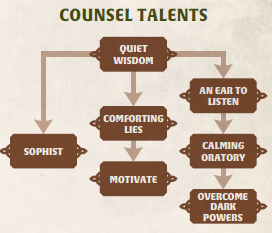
The Gamemaster’s chapter. Along with some generally useful advice, the chapter focuses on how to make things as Sword and Sorcery as possible, and specifically Conan-like, in a way that made even me understand the general feel of it. It discusses ways to use the system’s mechanics (such as Doom spends) in order to set this atmosphere, as well as how to resolve various situations in the “right” way, genre-wise. Finally, it’s full of good, forward-thinking advice, straight from the modern arena of GM theory: Failing forward at a cost, how to say “Yes, and”, rolling only when it’s dangerous or difficult (and there are rules for insta-success for other situations), etc. Good read, a lot of useful advice to implement.
The Hyborian World chapter. Wow, there’s a lot of world here. 70 pages worth of world, with enough general and specific details to allow a player to “get” their homeland, and enough for the GM to set specific atmospheres and styles for each land. There’s a good amount of adventure hooks, but I’m a sucker for published adventures and already reading Jeweled Thrones of the Earth, so, whatever man, whatever.
Sore Points
Character creation. There are a lot of things to like about the chargen process – you get to choose (or roll for) specific stories for your caste, archetype, nature, education and war experience (in this world, everyone is affected by war), but it’s a bit overcomplicated in a confusing way. Each stage has mandatory skills and elective skills, and you can’t choose the same them twice in a row or something? And you can just distribute attributes, but instead choose Aspects, or something? Anyway, creating a character is a cool if time-consuming task, and the technical part is probably more complicated than is should be.
Proofreading in the Encounters chapter and beyond. It’s a great chapter, I like the simple Field of Expertise concept for enemies and NPCs, and the creatures are both varied and generally interesting. But the proofreaders seemed to have skimmed through the text a bit too quickly, starting with this chapter and going forward, with various mistakes that come up enough for me to notice it’s a consistent problem.
Text heavy. There’s a lot of text in this book, and sometimes it isn’t easy to find what you’re looking for. The single sentence you’re looking for might be somewhere deep inside a large paragraph, with lots of text that doesn’t add much actual content. This is especially noted in the sample adventure at the end of the book: The adventure seems like lots of fun, but it won’t be easy to run, since the useful information you’ll actually need during the game is hidden among columns of not-immediately-useful text.
Heroes of the Age. A cool chapter, with lots of interesting NPCs “drawn from the creative talents of backers that supported the campaign [for the game] on Kickstarter”. However, there are less than a handful of female characters among dozens of males, which is doubly jarring after reading the boxed text the writers themselves have included in the discussion of Sword and Sorcery tropes, under the title “Where are the women?”, with this advice: “The gamemaster is encouraged to mix things up from time to time, using male and female characters equally when they can serve the story”.
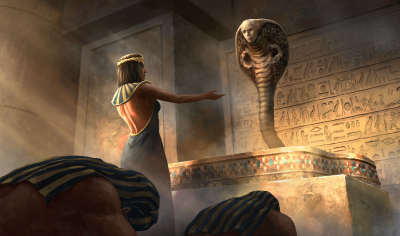
Would you like it?
Woof, I haven’t even talked about Sorcery (there’s a whole chapter, several interesting and flexible spells, the patron system is great) or the way you can use Momentum to activate weapon qualities when you attack, or how Fortune points can be used to add details to the story or for a rare auto-success, or how the rules for groups of enemies allow them to be dangerous yet manageable at the same time. But let’s put all of that aside for now, and ask: Would you enjoy playing this?
Yes, if you enjoy tactical combat. And by “tactical” I don’t mean “counting squares” (distances are abstract, like in Edge of the Empire), but “taking note of several different details and using them in a clever way to overcome the obstacles around you”. Combats in Conan can be quite sophisticated without being complicated, with the use of abstract zones and a nice idea called Guard that helps a person keep their inner parts inside their body. There are tons of different melee weapons, and the differences between them matter.
Yes, if you enjoy grim glory and deadly deeds. This game knows exactly what genre it wants to bring to the table, and it succeeds in doing so. If most of your players are on the same wavelength as this game you’ll have a blast, and the rules and atmosphere will help the rest of the players to get into the same mindset.
Yes, if you like flexible storytelling in a structured form. The players have a decent amount of narrative power in every scene, able to change or affect the scenery and ongoings thanks to their Talents and Fortune points, but ultimately most S&S adventures are pretty structured in form. Conan was free to go wherever he pleased, sure, but when he got there, he got into a specific adventure. After escaping from the Pits, or vanquishing the Queen, or rescuing the Lizard-Priest, he then went off to gods-know-where and got himself into another crazy shenanigan. Be like Conan! The book will explain how.
Conan: Adventures in an Age Undreamed Of is an excellent game, mainly for campaign-length play, and I’d love to give it a try on my table, for a few long months at least. Have fun saving the Dreaming West! Until the Picts arrive and destroy us all, that is.
This review was made on a PDF copy; I was a Kickstarter backer of the PDF version.
This article first appeared on Up to Four Players.
Pingback: Review - Mistborn Adventure Game - The Play's the Thing